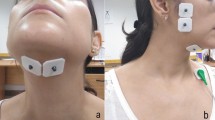Abstract
Research has shown that swallowing in adults is affected by bolus consistency. Little is known, however, regarding the effect of bolus consistency on swallowing in children. Electromyographic (EMG) data from typically developing five- and eight-year-old-children and adults were obtained from the following muscles as they swallowed boluses of different consistencies: (1) right upper lip, (2) right lower lip, (3) submental, and (4) laryngeal strap. Signal analyses included calculating EMG onset and offset and average EMG amplitude of muscle activity during swallowing. Findings revealed that by five years of age, children employ adultlike control strategies during swallowing: significant differences in duration and magnitude of muscle activity resulted as a function of bolus consistency. General observations revealed, however, that swallowing in children is characterized by muscle activity that is shorter in duration. Similarities and differences in the biomechanics of swallowing between children and adults are important to consider during clinical evaluations and treatment of children with dysphagia.
Similar content being viewed by others
Author information
Authors and Affiliations
Rights and permissions
About this article
Cite this article
Ruark, J., McCullough, G., Peters, R. et al. Bolus Consistency and Swallowing in Children and Adults. Dysphagia 17, 24–33 (2002). https://doi.org/10.1007/s00455-001-0098-0
Received:
Accepted:
Published:
Issue Date:
DOI: https://doi.org/10.1007/s00455-001-0098-0




